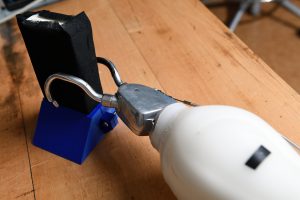
Prosthetics that have the ability to move on their own and that provide a sense of touch are better at helping users complete tasks accurately and with less mental effort than are artificial limbs that provide only one of those assets, according to a study led by Jeremy D. Brown, John C. Malone Assistant Professor in the Department of Mechanical Engineering. The team’s results appear in Nature Scientific Reports.
Controlled by muscle signals from the remaining portion of the limb, ordinary myoelectric prosthetics do not excel at helping people complete everyday tasks easily and with precision. Previous studies have shown users do better and can accomplish tasks more easily (with less mental effort) when these devices have the ability to move on their own (something called “autonomous control”) or are equipped with haptics: an artificial sense of touch.
Until now, though, no one has studied what happens when an artificial limb is equipped with both abilities.
In Brown’s study, individuals without amputation were given a prosthesis equipped with both haptic feedback and autonomous control and asked to complete a task that involves grasping and lifting a brittle object. Their results were compared to that of another group performing identical tasks using myoelectric prostheses with and without haptic feedback capabilities or autonomous control. During the tasks, both group members’ cognitive functions were assessed using functional near infrared spectroscopy (fNIRS), an imaging technique which uses light to assess the amount of oxygen in the brain’s prefrontal cortex as a way of measuring neural activity/mental effort.
“We found that the prosthesis with both haptic feedback and autonomous control allowed users to complete the tasks with greater performance and lower mental effort,” said Brown. “What we learned in this study brings us yet another step closer to developing artificial limbs that function more like healthy human limbs.”
Team members included Neha Thomas (Department of Biomedical Engineering); Alexandra J. Miller (Department of Mechanical Engineering); and Hasan Ayaz (School of Biomedical Engineering, Drexel University.)